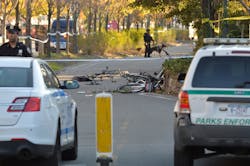Understanding and preventing tragedy in outdoor public areas
A Manhattan mile transformed into a killing field yesterday afternoon when a man rented a pickup truck and carried out his jihad. “Rent me starting at $19” read the sign on the grotesquely bent truck, a painful testament to the disproportionate economies-of-scale of asymmetric warfare. In the city where law enforcement, intelligence, and anti-terrorism capabilities have been constant since 9/11, bent bicycle frames littered the streets like post-carnival decorations. Eight innocents died before the pickup hit a school bus and came to a halt.
Reporters and anchors are asking, “what could law enforcement have done to prevent this attack?” The important thing to know is that law enforcement and intelligence personnel have been and continue to do everything they reasonably can within their scope of authority. This attack was not due to any failure on their part.
The three required elements of a crime in U.S. law are motive, means, and opportunity. The motive is wide-ranging but for consideration herein, we assume that motivation exists and is sufficient to embolden a deadly-force attack on others. Law enforcement and intelligence efforts (combined with coordinated preventative/defensive security measures) have ramped-up nationwide since 9/11, to the point that means and opportunity requirements for significant terrorism exceed the capabilities of most adversary groups. While no locations can be secured against all threats; protective money, time and effort have been allocated in a prioritized, methodical, and deliberate manner nationwide.
Tuesday’s attack is an unfortunate but poignant side-effect of responsible government resource prioritization; increasing means requirements and reducing opportunity at larger targets has shifted the available target opportunities to softer, smaller targets like the Manhattan bicycle path. As larger targets were hardened, smaller and “softer” targets became more attractive to adversaries.
This attack was enabled by minimal means requirements; a common vehicle with everyday operational skills was all that was needed. Minimal complexity, planning, logistics, communications, timing, secrecy, or funding thresholds stood in the way of success. Even a police traffic-stop 100 feet from the attack starting point would have been almost irrelevant. As the perpetrator was unassuming and law-abiding up to the moment of attack, police and intelligence personnel did everything in advance that could be asked of them.
The real chance to increase public safety in this and in many similar soft-target scenarios lies with the security designer and civil engineer. Engineering and traffic controls combined with architectural and security elements will reduce opportunity and increase means requirements. These classic force protection principles are neither cost-free nor 100 percent effective but are wisely employed in a distributed fashion providing reasonable protection at a reasonable cost. When optimized for each municipality (or town, park or business), they will increase security and safety while limiting cost and potential liability.
Urban planning and public safety concerns are converging; hardening critical infrastructure has left smaller, softer targets (including pedestrian and bicycle paths) as low-hanging fruit for opportunistic perpetrators. Terrorist organizations have actively spread these targeting suggestions to their followers, and the threat will persist for the foreseeable future.
This iteration of public security enhancement is in the hands of the planners, designers, architects, engineers, and law enforcement liaison personnel. Soft targets need not remain vulnerable, nor do they have to be transformed into unusable, unwelcoming space in order to provide safety.
About the Author:
Walter "Cal" Smith is an accomplished tactical security officer and security system engineer. He specializes in protecting high-value operations in high-threat situations for Butchko Inc. and he combines practical expertise and experience in field security operations with engineering analysis on sensor systems and integrated security technology. Cal has demonstrated experience in the analysis of security risk, specialized technology countermeasures, explosive ordinance disposal, reliability analysis, sensor characterization, and project management. Mr. Smith has over two decades of experience in tactical security operations and advanced systems design. He has fielded, analyzed, and utilized advanced sensors, weapons systems, and tactics. His specialized knowledge has involved the protection of nuclear weapons systems and support operations.
